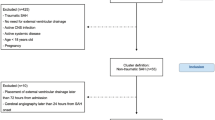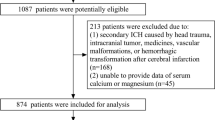Abstract
The aim of this study was to determine the relationship between serum and cerebrospinal fluid (CSF) magnesium (Mg+2) levels, Glasgow Coma Scores (GCS), and 7-day mortality in acute stroke patients. Patients with acute ischemic or hemorrhagic stroke arriving within the first 3 h of symptoms were included in the study. The control group consisted of healthy volunteers. GCS was determined, and blood and CSF samples were taken in order to establish serum and CSF glucose, Mg+2, sodium, potassium, calcium, and chlorine levels. Mortality was recorded at 7 days after admission. CSF Mg+2 in the ischemic infarct group was significantly lower than in the control group (p = 0.006). CSF Mg+2 in the ischemic infarct patients with a GCS ≤ 8 were significantly lower (p = 0.002) than controls and in ischemic infarct patients with a GCS ≥9. In the ischemic stroke patients, CSF Mg+2 and GCS were significantly correlated (r = 55, p = 0.031). CSF Mg+2 levels in ischemic stroke patients who died within 7 days were significantly lower than controls, ischemic stroke patients who survived, and hemorrhagic stroke patients who died (p = 0.002, p = 0.042, and p = 0.005, respectively). Low CSF Mg+2 levels in patients with acute ischemic stoke at admission predicted a higher 1-week mortality.


Similar content being viewed by others
References
Shivakumar K (2001). Model of cardiovascular injury in magnesium deficiency. Med Hypotheses 56:110–113.
Marinov MB, Harbaugh KS, Hoopes PJ, Pikus HJ, Harbaugh RE (1996). Neuroprotective effects of preischemia intraarterial magnesium sulfate in reversible focal cerebral ischemia. J Neurosurg 85:117–124.
Izumi Y, Roussel S, Pinard E, Seylaz J (1991). Reduction of infarct volume by magnesium after middle cerebral artery occlusion in rats. J Cereb Blood Flow Metab 11:1025–1030.
McIntosh TK, Vink R, Yamakami I, Faden AI (1989). Magnesium protects against neurological deficit after brain injury. Brain Res 482:252–260.
Chi OZ, Pollak P, Weis HR (1990). Effects of magnesium sulphate and nifedipine on regional cerebral blood flow during middle cerebral artery ligation in the rat. Arch Int Pharmacodyn Ther 304:196–205.
Iseri LT, French JH (1984). Magnesium: nature’s physiologic calcium blocker. Am Heart J 108:188–193.
Mori H, Masaki H, Yamakura T, Mishina M (1992). Identification by mutagenesis of a Mg(2+)-block site of the NMDA receptor channel. Nature 358:673–675.
Smith DAS, Connick JH, Stone TW (1989). Effect of changing extracellular levels of magnesium on spontaneous activity and glutamate release in the mouse neocortical slice. Br J Pharmacol 97:475–482.
Ghiribi O, Callebert J, Verrechia C, Plotkine M, Boulu RG (1995). Blockers of NMDA-operated channels decrease glutamate and aspartate extracellular accumulation in striatum during forebrain ischaemia in rats. Fund Clin Pharmacol 9:141–146.
Ascherio A, Rimm EB, Hernan MA, Giovannucci EL, Kawachi I, Stampfer MJ, Willett WC (1998). Intake of potassium, magnesium, calcium and fiber and risk of stroke among US man. Circulation 98:1198–1204.
Lampl Y, Geva D, Gilad R, Yehiel E, Ronen L, Sarova-Pinhas I (1998). Cerebrospinal fluid magnesium level as a prognostic factor in ischaemic stroke. J Neurol 245:584–588.
Amighi J, Sabeti S, Schlager O, Mlekusch W, Exner M, Lalouschek W, Ahmadi R, Minar E, Schillinger M (2004). Low serum magnesium predicts neurological events in patients with advanced atherosclerosis. Stroke 35(1):22–27.
Helpern JA, Vande Linde AM, Welch KM, Levine SR, Schultz LR, Ordidge RJ, Halvorson HR, Hugg JW (1993). Acute elevation and recovery of intracellular [Mg2+] following human focal cerebral ischemia. Neurology 43:1577–1581.
Vande Linde AM, Chopp M (1991). Chronic changes in brain Mg2+ concentration after forebrain ischemia in the rat. Metab Brain Dis 6:199–206.
Vink R, Heat DL, McIntosh TK (1996). Acute and prolonged alterations in brain free magnesium following fluid percussion-induced brain trauma in rats. J Neurochem 66:2477–2483.
Lee MS, Wu YS, Yang DY, Lee JB, Cheng FC (2002). Significantly decreased extracellular magnesium in brains of gerbils subjected to cerebral ischemia. Clin Chim Acta 318:121–125.
Sakamoto T, Takasu A, Saitoh D, Kaneko N, Yanagawa Y, Okada Y (2005). Ionized magnesium in the cerebrospinal fluid of patients with head injuries. J Trauma 58(6):1103–1109.
Brewer R, Para A, Borel CO, Hopkins MB, Reynolds JD (2001). Intravenous magnesium sulfate does not increase ventricular CSF ionised magnesium concentration of patients with intracranial hypertension. Clin Neurophysiol 24:341–345.
Fuchs-Buder T, Tramer MR, Tassonyi E (1997). Cerebrospinal fluid passage of intraveneus magnesium sulfate in neurosurgical patients. J Neurosurg Anesthesiol 9:324–328.
Von Holst H, Mathiesen T (1990). Electrolyte concentrations in serum and CSF following subarachnoid haemorrhage. BrJ Neurosurg 4(2):123–126.
Macdonald RL, Curry DJ, Aihara Y, Zhang ZD, Jahromi BS, Yassari R (2004). Magnesium and experimental vasospasm. J Neurosurg 100(1):106–110.
McKee JA, Brewer RP, Macy GE, Borel CO, Reynolds JD, Warner DS (2005). Magnesium neuroprotection is limited in humans with acute brain injury. Neurocrit Care 2:342–351.
Author information
Authors and Affiliations
Corresponding author
Rights and permissions
About this article
Cite this article
Bayır, A., Ak, A., Kara, H. et al. Serum and Cerebrospinal Fluid Magnesium Levels, Glasgow Coma Scores, and In-Hospital Mortality in Patients with Acute Stroke. Biol Trace Elem Res 130, 7–12 (2009). https://doi.org/10.1007/s12011-009-8318-9
Received:
Accepted:
Published:
Issue Date:
DOI: https://doi.org/10.1007/s12011-009-8318-9




